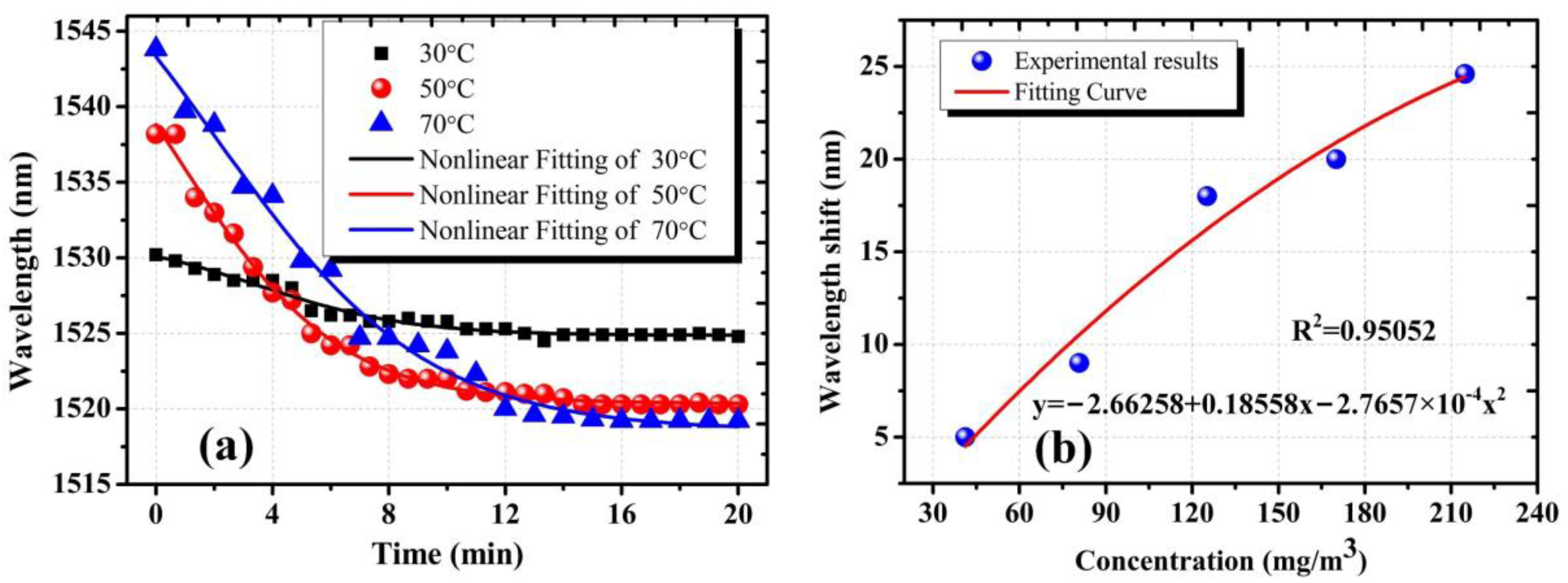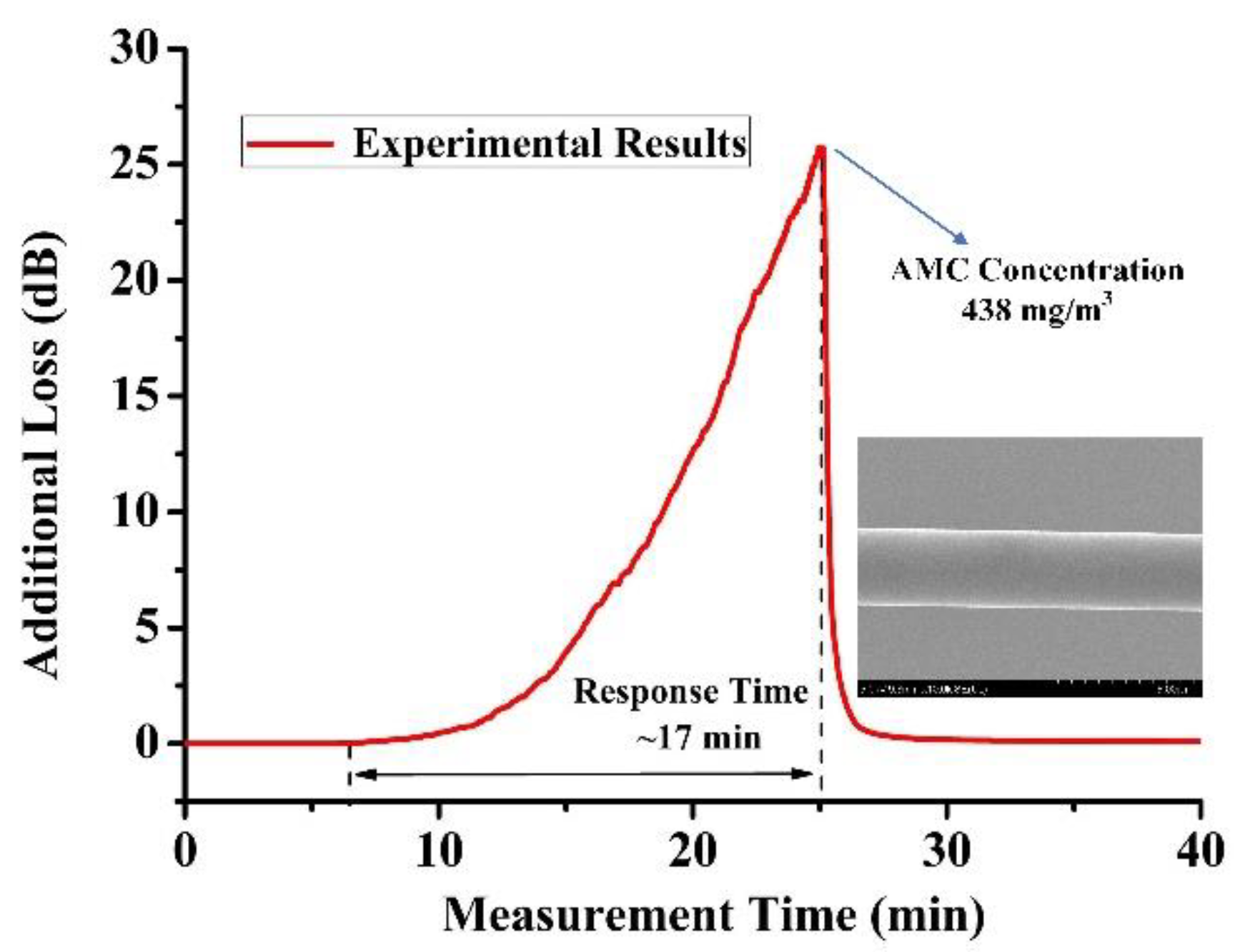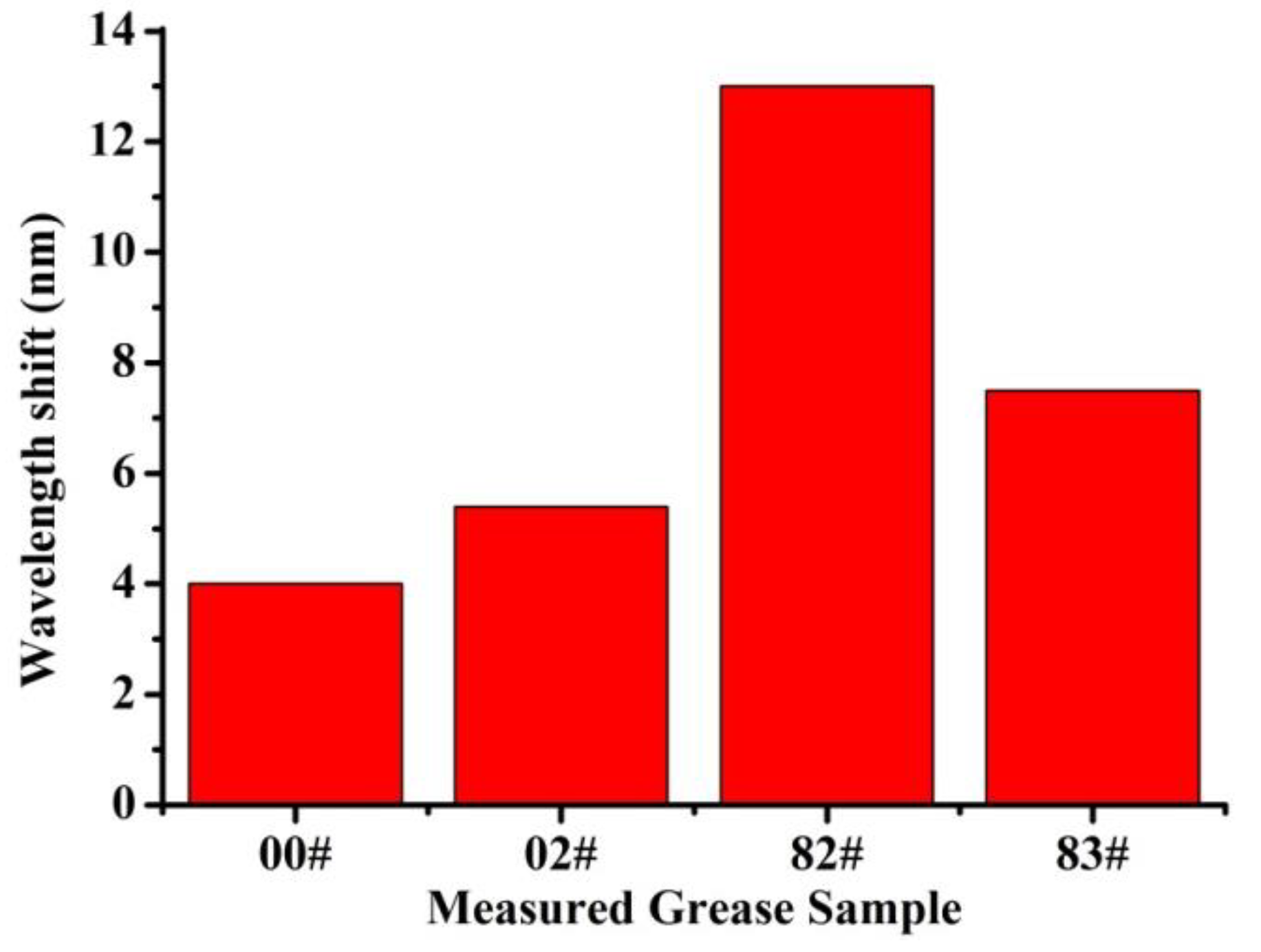A Novel Airborne Molecular Contaminants Sensor Based on Sagnac Microfiber Structure
Abstract
:1. Introduction
2. Sensor Configuration and Principle
3. Experiment
3.1. Silica Sensitive Coating Solution Preparation
3.2. Fabrication of Sagnac OMFs Loop Sensing Unit and Experimental Setup
3.3. Results and Discussion
3.4. The Technical Characteristic of the Proposed Sensors
3.5. The Feasibility of the Proposed Sensors
4. Conclusions
Author Contributions
Funding
Institutional Review Board Statement
Informed Consent Statement
Data Availability Statement
Acknowledgments
Conflicts of Interest
References
- Bien-Aimé, K.; Belin, C.; Gallais, L.; Grua, P.; Tovena-Pecault, I. Impact of storage induced outgassing organic contamination on laser induced damage of silica optics at 351 nm. Opt. Express 2009, 17, 18703–18713. [Google Scholar] [CrossRef] [Green Version]
- Yun, C.; Zhao, Y.; Hua, Y.; He, H.; Shao, J. Impact of organic contamination on laser-induced damage threshold of high reflectance coatings in vacuum. Appl. Surf. Sci. 2008, 254, 5990–5993. [Google Scholar]
- Ling, X.; Zhao, Y.; Shao, J.; Fan, Z. Effect of two organic contamination modes on laser-induced damage of high reflective films in vacuum. Thin Solid Film. 2010, 519, 296–300. [Google Scholar] [CrossRef]
- Bien-Aimé, K.; Néauport, J.; Tovena-Pecault, I.; Fargin, E.; Labrugère, C.; Belin, C.; Couzi, M. Laser induced damage of fused silica polished optics due to a droplet forming organic contaminant. Appl. Opt. 2009, 48, 2228–2235. [Google Scholar] [CrossRef] [Green Version]
- Pareek, R.; Kumbhare, M.N. Effect of oil vapor contamination on the performance of porous silica sol-gel antireflection-coated optics in vacuum spatial filters of high-power neodymium glass laser. Opt. Eng. 2008, 47, 023801. [Google Scholar] [CrossRef]
- Guo, L.; Shen, J. Dependence of the forward light scattering on the refractive index of particles. Opt. Laser Technol. 2018, 101, 232–241. [Google Scholar] [CrossRef]
- Chen, A.; Wang, S.; Liu, Y.; Yan, S.; Deng, T. Light scattering intensity field imaging sensor for in-situ aerosol analysis. ACS Sens. 2020, 5, 2061–2066. [Google Scholar] [CrossRef]
- Xiang, S.; You, H.; Miao, X.; Niu, L.; Yao, C.; Jiang, Y.; Zhou, G. An Ultra-Sensitive Multi-Functional Optical Micro/Nanofiber Based on Stretchable Encapsulation. Sensors 2021, 21, 7437. [Google Scholar] [CrossRef]
- Lou, J.; Tong, L.; Ye, Z. Modeling of silica nanowires for optical sensing. Opt. Express 2005, 13, 2135–2140. [Google Scholar] [CrossRef]
- Sun, Q.; Sun, X.; Jia, W.; Xu, Z.; Luo, H.; Liu, D.; Zhang, L. Graphene-Assisted Microfiber for Optical-Power-Based Temperature Sensor. IEEE Photonics Technol. Lett. 2015, 28, 383–386. [Google Scholar]
- Li, X.; Ding, H. A Stable Evanescent Field-Based Microfiber Knot Resonator Refractive Index Sensor. IEEE Photonics Technol. Lett. 2014, 26, 1625–1628. [Google Scholar] [CrossRef]
- Tong, L.; Lou, J.; Mazur, E. Single-mode guiding properties of subwavelength-diameter silica and silicon wire waveguides. Opt. Express 2003, 12, 1025–1035. [Google Scholar] [CrossRef] [PubMed]
- Zhu, X.; Geng, J.; Sun, D.; Ji, Y.; Zhang, G. A novel Optical Fiber Sensor Based on Microfiber Mach-Zehnder Interferometer with Two Spindle-Shaped Structures. IEEE Photonics J. 2021, 13, 1. [Google Scholar] [CrossRef]
- Wang, Y.; Zhang, H.; Cui, Y.; Duan, S.; Liu, B. A complementary-DNA-enhanced fiber-optic sensor based on microfiber-assisted Mach-Zehnder interferometry for biocompatible pH sensing. Sens. Actuators B Chem. 2021, 332, 129516. [Google Scholar] [CrossRef]
- Ahsani, V.; Ahmed, F.; Jun, M.; Bradley, C. Tapered Fiber-Optic Mach-Zehnder Interferometer for Ultra-High Sensitivity Measurement of Refractive Index. Sensors 2019, 19, 1652. [Google Scholar] [CrossRef] [PubMed] [Green Version]
- Zhang, H.; Cong, B.; Zhang, F.; Qi, Y.; Hu, T. Simultaneous measurement of refractive index and temperature by Mach-Zender cascaded with FBG sensor base on milti-core microfiber. Opt. Commun. 2021, 493, 126985. [Google Scholar] [CrossRef]
- Ran, Z.; He, X.; Rao, Y.; Sun, D.; Qin, X.; Zeng, D.; Chu, W.; Li, X.; Wei, Y. Fiber-optic microstructure sensors: A review. Photonic Sens. 2021, 11, 227–261. [Google Scholar] [CrossRef]
- Ran, Y.; Long, J.; Xu, Z.; Hu, D.; Guan, B.O. Temperature monitorable refractometer of microfiber Bragg grating using a duet of harmonic resonances. Opt. Lett. 2019, 44, 3186–3189. [Google Scholar] [CrossRef]
- Zhang, X.; Zou, X.; Luo, B.; Pan, W.; Peng, W. Optically functionalized microfiber Bragg grating for RH sensing. Opt. Lett. 2019, 44, 4646–4649. [Google Scholar] [CrossRef]
- Ran, Y.; Hu, D.; Xu, Z.; Long, J.; Guan, B.O. Vertical-fluid-array induced optical microfiber long period grating (VIOLIN) refractometer. J. Lightwave Technol. 2020, 38, 2434–2440. [Google Scholar] [CrossRef]
- Peng, Y.; Zhao, Y.; Hu, X.G.; Chen, M.Q. Humidity sensor based on unsymmetrical U-shaped twisted microfiber coupler with wide detection range. Sens. Actuators B Chem. 2019, 290, 406–413. [Google Scholar] [CrossRef]
- Wei, F.; Liu, D.; Mallik, A.K.; Farrel, G.; Wu, Q.; Peng, G.D.; Semenova, Y. Magnetic Field Sensor Based on a Tri-Microfiber Coupler Ring in Magnetic Fluid and a Fiber Bragg Grating. Sensors 2019, 19, 5100. [Google Scholar] [CrossRef] [Green Version]
- Zhang, L.; Wang, Y.; Wu, H.; Hou, M.; Wang, Y. A ZnO nanowire-based microfiber coupler for all-optical photodetection applications. Nanoscale 2019, 11, 8319–8326. [Google Scholar] [CrossRef]
- Wang, J.; Li, X.; Ju, J.; Li, K. High-Sensitivity, Large Dynamic Range Refractive Index Measurement Using an Optical Microfiber Coupler. Sensors 2019, 19, 5078. [Google Scholar] [CrossRef] [Green Version]
- Sun, L.P.; Yuan, Z.; Huang, T.; Sun, Z.; Guan, B.O. Ultrasensitive sensing in air based on Sagnac interferometer working at group birefringence turning point. Opt. Express 2019, 27, 29501–29509. [Google Scholar] [CrossRef]
- Li, X.; Nguyen, L.V.; Zhao, Y.; Heike, E.-H.; Warren-Smith, S.C. High-sensitivity Sagnac-interferometer biosensor based on exposed core microstructured optical fiber. Sens. Actuators B Chem. 2018, 269, 103–109. [Google Scholar] [CrossRef]
- Gao, S.; Sun, L.P.; Jie, L.; Jin, L.; Guan, B.O. High-sensitivity DNA biosensor based on microfiber Sagnac interferometer. Opt. Express 2017, 25, 13305–13313. [Google Scholar] [CrossRef]
- Chowdhury, S.; Verma, S.; Gangopadhyay, T.K. A comparative study and experimental observations of optical fiber sagnac interferometric based strain sensor by using different fibers. Opt. Fiber Technol. 2019, 48, 283–288. [Google Scholar] [CrossRef]
- Liu, T.; Zhang, H.; Xue, L.; Liu, B.; Liu, H.; Huang, B.; Sun, J.; Wang, D. Highly sensitive torsion sensor based on side-hole-fiber Sagnac interferometer. IEEE Sens. J. 2019, 19, 7378–7382. [Google Scholar] [CrossRef]
- Chen, Y.; Han, Q.; Liu, T.; Lue, X. Self-temperature-compensative refractometer based on singlemode–multimode–singlemode fiber structure. Sens. Actuators B Chem. 2015, 212, 107–111. [Google Scholar] [CrossRef]
- Liu, D.; Mallik, A.K.; Yuan, J.; Yu, C.; Farrel, G.; Semenova, Y.; Wu, Q. High sensitivity refractive index sensor based on a tapered small core single-mode fiber structure. Opt. Lett. 2015, 40, 4166–4169. [Google Scholar] [CrossRef] [Green Version]
- Wang, X.; Wang, J.; Wang, S.S.; Liao, Y.P. Fiber-Optic Salinity Sensing With a Panda-Microfiber-Based Multimode Interferometer. J. Lightwave Technol. 2017, 35, 5086–5091. [Google Scholar] [CrossRef]
- Zhou, G.; Niu, L.; Jiang, Y.; Liu, H.; Lv, H. Sensing of airborne molecular contaminants based on microfiber coupler with mesoporous silica coating. Sens. Actuators A Phys. 2019, 287, 1–7. [Google Scholar] [CrossRef]
- Li, K.; Zhang, T.; Liu, G.; Zhang, N.; Zhang, M.; Wei, L. Ultrasensitive optical microfiber coupler based sensors operating near the turning point of effective group index difference. Appl. Phys. Lett. 2016, 109, 101101. [Google Scholar] [CrossRef]
- Lamont, R.G.; Johnson, D.C.; Hill, K.O. Power transfer in fused biconical-taper single-mode fiber couplers: Dependence on external refractive index. Appl. Opt. 1985, 24, 327–332. [Google Scholar] [CrossRef]
- Morishita, K.; Yamazaki, K. Wavelength and polarization dependences of fused fiber couplers. J. Lightwave Technol. 2011, 29, 330–334. [Google Scholar] [CrossRef]
- Tewari, R.; Thyagarajan, K. Analysis of tunable single-mode fiber directional couplers using simple and accurate relations. J. Lightwave Technol. 1986, 4, 386–390. [Google Scholar] [CrossRef]
- Pu, S.; Luo, L.; Tang, J.; Mao, L.; Zeng, X. Ultrasensitive Refractive-Index Sensors Based on Tapered Fiber Coupler With Sagnac Loop. IEEE Photonics Technol. Lett. 2016, 28, 1073–1076. [Google Scholar] [CrossRef]
- Ranjbar, Z.; Jannesari, A.; Rastegar, S.; Montazeri, S. Study of the influence of nano-silica particles on the curing reactions of acrylic-melamine clear-coats. Prog. Org. Coat. 2009, 66, 372–376. [Google Scholar] [CrossRef]
- Payne, F.P.; Hussey, C.D.; Yataki, M.S. Polarisation analysis of strongly fused and weakly fused tapered couplers. Electron. Lett. 1985, 21, 561–563. [Google Scholar] [CrossRef] [Green Version]
- Bai, Y.; Miao, Y.; Zhang, H.; Yao, J. Simultaneous Measurement of Temperature and Relative Humidity Based on a Microfiber Sagnac Loop and MoS2. J. Lightwave Technol. 2020, 38, 840–845. [Google Scholar] [CrossRef]
- Han, C.; Ding, H.; Li, X.; Dong, S. Temperature insensitive refractive index sensor based on single-mode micro-fiber Sagnac loop interferometer. Appl. Phys. Lett. 2014, 104, 181906. [Google Scholar]
- Vargas-Rodriguez, E.; Guzman-Chavez, A.D.; Garcia-Ramirez, M.A. Tunable optical filter based on two thermal sensitive layers. IEEE Photonics Technol. Lett. 2018, 30, 1776–1779. [Google Scholar] [CrossRef]








Publisher’s Note: MDPI stays neutral with regard to jurisdictional claims in published maps and institutional affiliations. |
© 2022 by the authors. Licensee MDPI, Basel, Switzerland. This article is an open access article distributed under the terms and conditions of the Creative Commons Attribution (CC BY) license (https://creativecommons.org/licenses/by/4.0/).
Share and Cite
Zhou, G.; Xiang, S.; You, H.; Li, C.; Niu, L.; Jiang, Y.; Miao, X.; Xie, X. A Novel Airborne Molecular Contaminants Sensor Based on Sagnac Microfiber Structure. Sensors 2022, 22, 1520. https://doi.org/10.3390/s22041520
Zhou G, Xiang S, You H, Li C, Niu L, Jiang Y, Miao X, Xie X. A Novel Airborne Molecular Contaminants Sensor Based on Sagnac Microfiber Structure. Sensors. 2022; 22(4):1520. https://doi.org/10.3390/s22041520
Chicago/Turabian StyleZhou, Guorui, Siheng Xiang, Hui You, Chunling Li, Longfei Niu, Yilan Jiang, Xinxiang Miao, and Xiufang Xie. 2022. "A Novel Airborne Molecular Contaminants Sensor Based on Sagnac Microfiber Structure" Sensors 22, no. 4: 1520. https://doi.org/10.3390/s22041520




